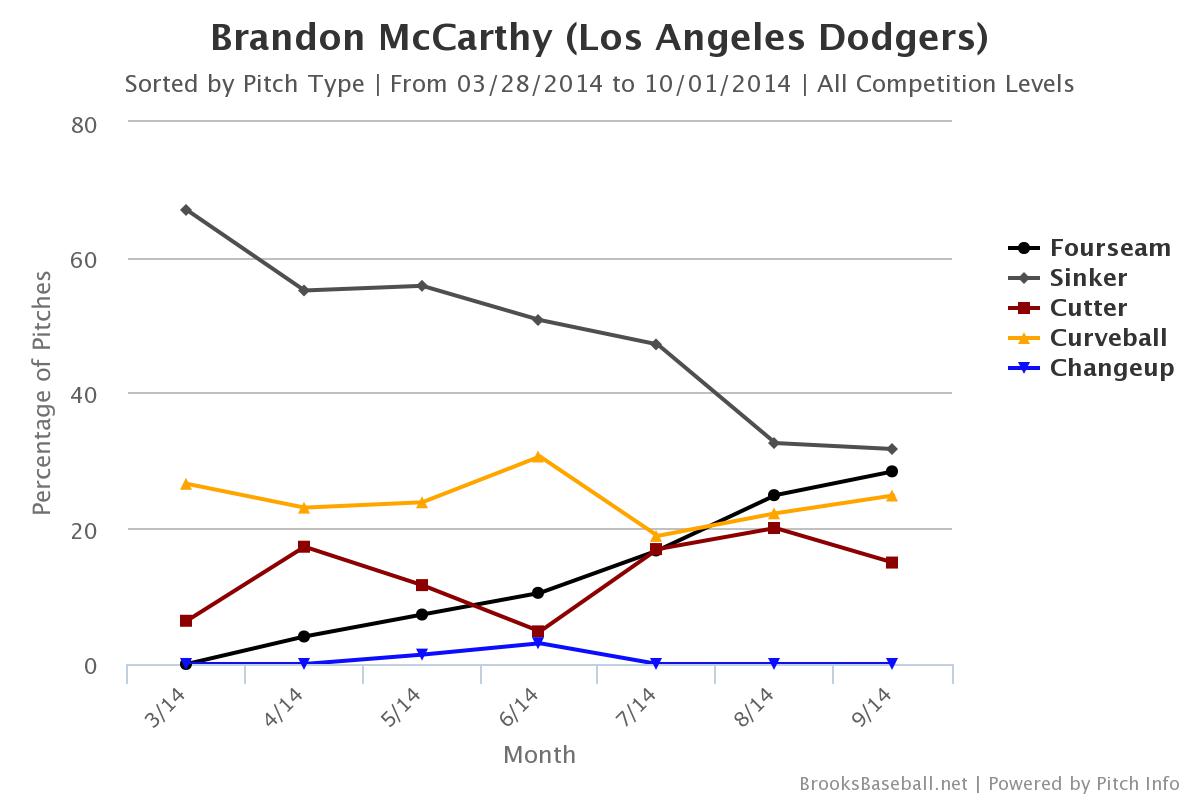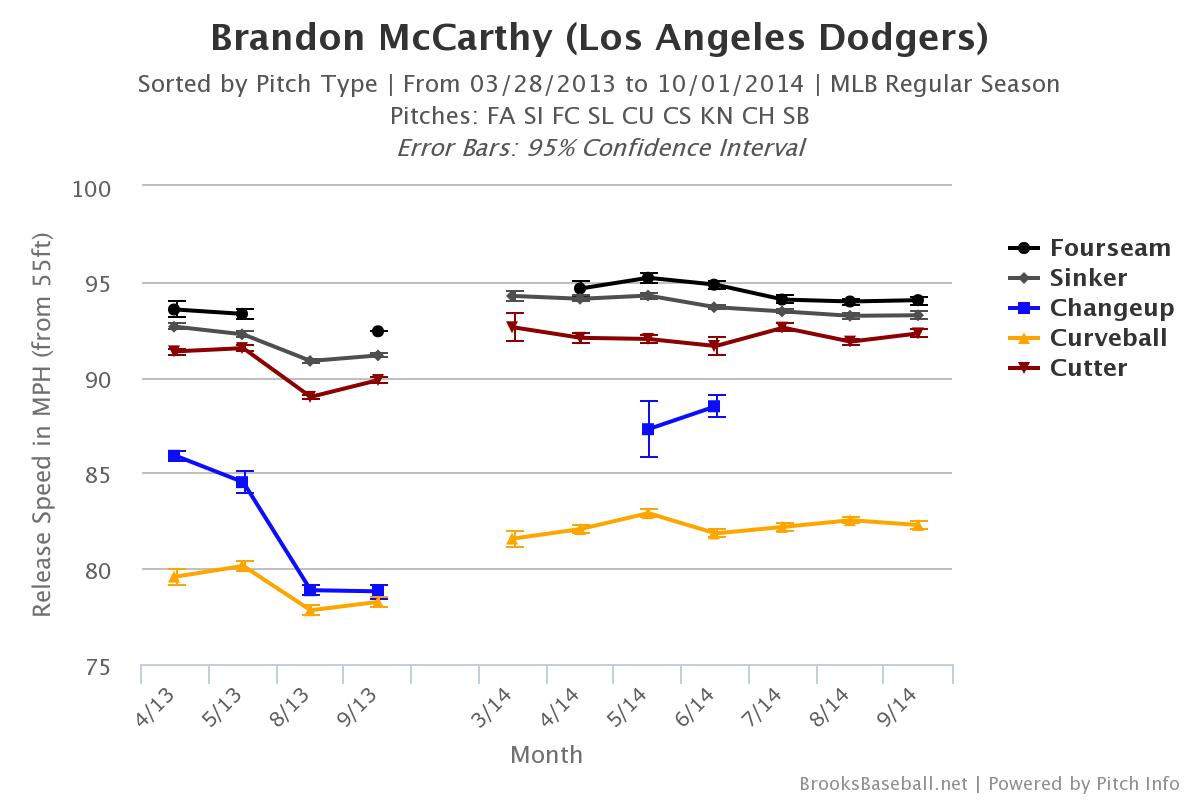The late rounds of fantasy baseball drafts are filled with players who have questions surrounding them. It’s usually not too difficult to categorize these players, particularly in terms of starting pitching. There’s the post-hype group (Trevor Bauer, Kevin Gausman, Tony Cingrani), the declining veteran tier (CC Sabathia, Dan Haren, Bartolo Colon), and the unproven prospect tier (Noah Syndergaard, Andrew Heaney, Archie Bradley). Several high floor, low ceiling options (Ervin Santana, Kyle Lohse, Wei-Yin Chen) and volatile injury-prone pitchers (Clay Buchholz, Matt Garza) tend to remain on the board for quite a while as well. In recent years, Brandon McCarthy has generally been perceived by the fantasy community as someone who falls into one of the latter two categories. Is this perception accurate? What can be expected from McCarthy in 2015?
Let’s take a look at McCarthy’s production both before and after he was traded to the Yankees on July 6th last season:
| W | L | GS | IP | K/9 | BB/9 | LOB% | GB% | HR/FB | WHIP | ERA | xFIP | SIERA | |
|---|---|---|---|---|---|---|---|---|---|---|---|---|---|
| w/ Ari | 3 | 10 | 18 | 109.2 | 7.63 | 1.64 | 66.70% | 55.30% | 20.00% | 1.38 | 5.01 | 2.88 | 2.99 |
| w/ NYY | 7 | 5 | 14 | 90.1 | 8.17 | 1.3 | 76.90% | 49.10% | 12.80% | 1.15 | 2.89 | 2.85 | 2.97 |
At first glance, it looks as though he was unlucky in Arizona based on the high .345 BABIP and 20.0% HR/FB rates combined with the extreme inability to strand runners (66.7% LOB%). His xFIP and SIERA marks were nearly identical with both teams, suggesting that his results in Arizona and New York should have been similar. Yet his ratios with the Diamondbacks (5.01 ERA, 1.38 WHIP) were far worse than those when pitching for the Yankees (2.89 ERA, 1.15 WHIP). Was he unlucky in Arizona, lucky in New York, or somewhere in between?
Was McCarthy’s pitch selection an issue? Let’s check out his pitch usage as the season progressed:

| Month | Fourseam | Sinker | Cutter | Curveball | Changeup |
|---|---|---|---|---|---|
| 3/14 | 0.00 | 67.02 | 6.38 | 26.6 | 0.00 |
| 4/14 | 4.06 | 55.13 | 17.31 | 23.08 | 0.00 |
| 5/14 | 7.3 | 55.82 | 11.64 | 23.87 | 1.38 |
| 6/14 | 10.5 | 50.77 | 4.81 | 30.63 | 3.06 |
| 7/14 | 16.76 | 47.17 | 16.96 | 18.91 | 0.00 |
| 8/14 | 24.92 | 32.61 | 20.07 | 22.24 | 0.00 |
| 9/14 | 28.43 | 31.73 | 14.97 | 24.87 | 0.00 |
Featuring a sinker-heavy repertoire in the hitter-friendly confines of Chase Field might seem like a good idea, but predictability is generally not. When a major league hitter knows what’s coming over half of the time, he’s going to make you pay sooner or later. That’s reflected in the .319/.342/.468 triple slash that was produced against McCarthy’s sinker last season. Perhaps he wasn’t so unlucky over the first few months after all. However, once he decided to cut down on his sinker usage and throw more fourseam fastballs and cutters, his results improved dramatically.
Pitch selection wasn’t the only major difference for McCarthy last season. Here’s a chart outlining his average velocity per pitch on a monthly basis from 2013-14:

| Month | Fourseam | Sinker | Change | Curve | Cutter |
|---|---|---|---|---|---|
| 4/13 | 93.54 | 92.64 | 85.89 | 79.57 | 91.35 |
| 5/13 | 93.31 | 92.24 | 84.51 | 80.13 | 91.52 |
| 8/13 | 0.00 | 90.85 | 78.86 | 77.81 | 88.97 |
| 9/13 | 92.4 | 91.14 | 78.8 | 78.25 | 89.85 |
| Month | Fourseam | Sinker | Change | Curve | Cutter |
|---|---|---|---|---|---|
| 3/14 | 0.00 | 94.25 | 0.00 | 81.56 | 92.61 |
| 4/14 | 94.64 | 94.1 | 0.00 | 82.06 | 92.06 |
| 5/14 | 95.2 | 94.27 | 87.28 | 82.89 | 92 |
| 6/14 | 94.84 | 93.66 | 88.48 | 81.83 | 91.63 |
| 7/14 | 94.06 | 93.44 | 0.00 | 82.17 | 92.59 |
| 8/14 | 93.96 | 93.21 | 0.00 | 82.52 | 91.86 |
| 9/14 | 94.03 | 93.24 | 0.00 | 82.27 | 92.29 |
McCarthy attributes his across-the-board velocity increase, as well as his improved durability, to a new workout regimen that’s more weight-based to maintain strength and stamina. While it’s difficult to know for sure if this new training technique was the main reason behind his ’14 results, the numbers suggest that there might be some truth behind these claims.
Speaking of durability, McCarthy’s 200 innings pitched represent the highest total of his career by a substantial margin. In fact, he’s only reached the 150 IP mark one other time in his professional career. For a 31 year old starting pitcher who’s been around for a decade now, that’s not a particularly reliable track record.
While you might think that McCarthy would be destined to sign with the Reds as a free agent, perhaps he was scared at the thought of making half of his starts in a such a favorable ballpark for hitters (Get it? McCarthy? Reds? Scared? *dodges tomato* Moving on…). Fortunately for fantasy owners, he couldn’t have landed in a more favorable situation than in LA with the Dodgers. Over the past three seasons, Dodger Stadium has finished 27th, 28th, and 25th in terms of park factor for runs scored, solidifying it’s reputation as a pitcher-friendly ballpark. By replacing Hanley Ramirez, Dee Gordon, and Matt Kemp with Jimmy Rollins, Howie Kendrick, and just about any other outfielder (Joc Pederson?), the defense should be vastly improved as well.
So if you’re interested in a late round (NFBC ADP of 270) groundball pitcher (52.6% GB% – 14th highest in MLB) with above average stuff and great command (5.30 K/BB ratio – 9th best in MLB), keep Brandon McCarthy in mind on draft day. Not only would he make a nice addition to your twitter feed, but he projects as a fine fantasy option as well.


